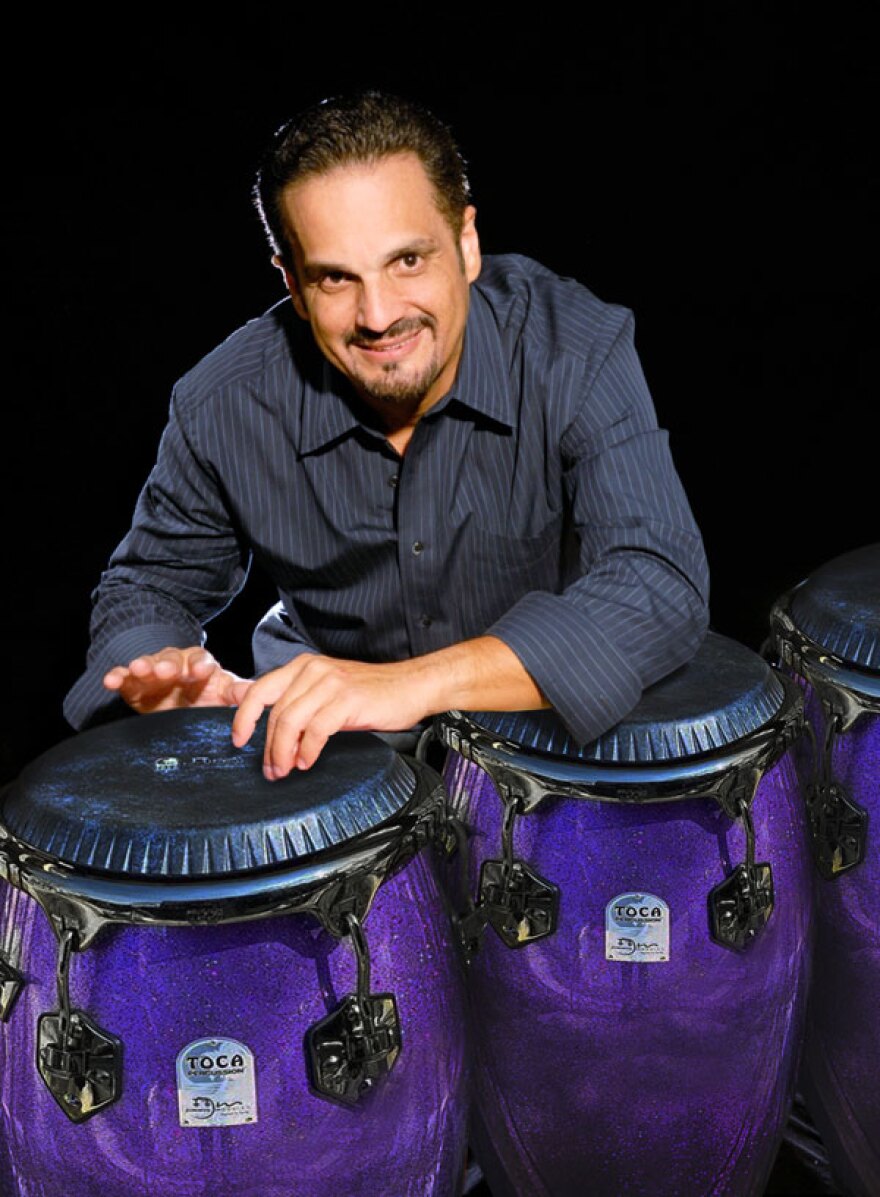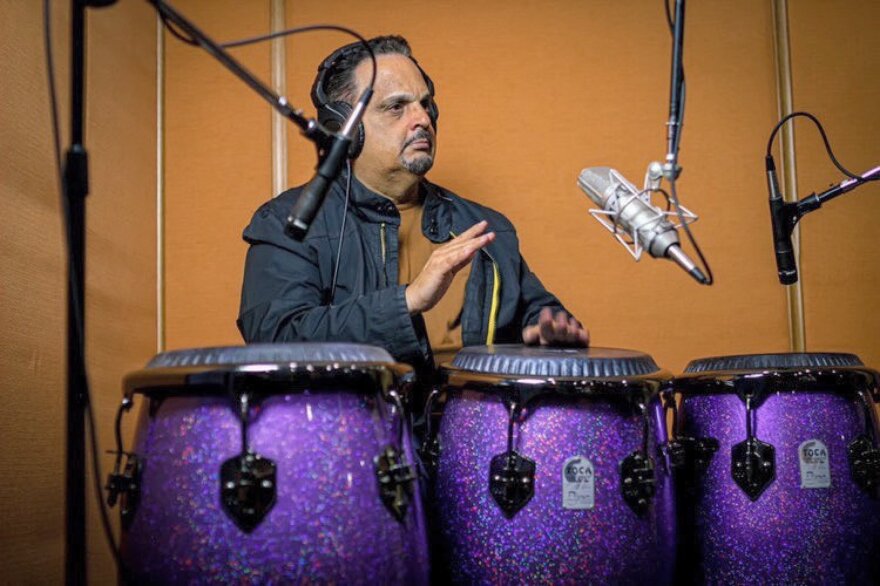Jimmie Morales, one of Puerto Rico’s most prolific percussionists, died on March 16 at his home in Gurabo, Puerto Rico. He was 63.
His family shared news of his passing on social media, without stating a cause.
Highly respected as a live performer as well as a studio musician, Morales had a long and celebrated association with Gilberto Santa Rosa. He appeared on more than 250 recordings, primarily as a conguero. His signature sound was a defined slap — known by players as golpe seco (dry stroke) — that is used to keep time within the repetitive patterns known as tumbaos. Because of this trademark, he became known by a nickname, “Mr. Slap.”
A Conguero’s Conguero: A Memoir of Jimmie Morales, a new book by Bella Martínez with a translation by Ronald P.S. Vázquez, confirms the high regard with which Morales was held by his peers. Among them is the famed bongocero Johnny "Dandy" Rodríguez. “Jimmie is one of the best congueros I’ve ever met,” he says. “His complimentary style adapts to the needs of any orchestra in which he plays. He is a tremendous accompanying musician.”
Morales first came to public attention with the orchestra of famed bandleader and timbale player Willie Rosario, where he spent eight years performing all over Latin America and stateside. Rosario had a reputation for a rhythm section that ran like a well-oiled machine, earning the nom de plum “Mr. Afinque” (Mr. Tight Rhythm). With Morales in the conga chair, the orchestra achieved great success on albums now considered classics, like From the Depth of My Brain, El Rey Del Ritmo, and Nuevos Horizontes.
Percussionist and arranger José Madera, who met Morales in the context of the Rosario band, describes his contribution as unique. “I had written three or four hit arrangements for them and so that’s when I first saw him play,” Madera says. “In my humble opinion he was the best conga player that Willie Rosario’s orchestra ever had.”
David Rosado Cuba, who played timbales in groups with Jimmie on many an occasion, extends that praise to virtually any musical setting. “Playing alongside Jimmie was like riding first class on an airplane,” he says. “He was an inspiration to everyone who ever performed or recorded with him.”
Jimmie Morales Siscot was born on Sept. 10, 1957 in Bridgeport, Conn., to Jaime Morales and Zoraida Siscot. A boyhood fan of The Beatles, he took up the guitar as his first instrument. At age 9, he moved with his family to the municipality of Bayamon, Puerto Rico, where he became fascinated with Afro-Cuban-based dance music (salsa) by listening to radio station KBM. He fell in love with the conga drum through participating in a local parranda (Puerto Rican Christmas party and musical procession).
By his high school years, Morales was an avid record collector, and with his photographic memory he became an expert on the entire catalogue produced by Fania Records. The industry leader in the genre, Fania had a roster of the best-known artists of the day. One of them would become Jimmy’s hero: conguero and future National Endowment of The Arts Jazz Master Ray Barretto.
Morales worked locally — with vocalist Tito Allen, Beto Tirado’s la Predilecta and others —while studying to become an orthopedic technician. Then bassist Edwin Morales (no relation), the leader of Mulenze, asked him to record a conga track for the tune “No Hay Manera Filomena.” Three others had failed before him, and his performance opened the door to eventually become the most sought-after conguero on the island.
His association with Willie Rosario began in 1978, when conguero Papo Pepin left the band to work with Roberto Roena and His Apollo Sound. In many ways, the Rosario band was modeled after that of legendary Puerto Rican vocalist Tito Rodríguez and his orchestra. A member of the Big 3 (along with Machito and Tito Puente) Rodríguez was a stickler for rhythmic precision to match his pristine voice. It has been said that he wouldn’t allow his timbale player to venture a fill without his permission.

It is this aesthetic, serving the needs of the vocalist and the dancer, that Morales came to experience under Rosario’s tutelage. “From Willie,” says David Rosado Cuba, “Jimmie learned the value of teamwork, discipline, professionalism, punctuality. Willie really mentored him even showing Jimmie about how to tune the congas for performing in a band.”
Morales also brought a rhythmic intensity that was the perfect match for Rosario’s disciplined sense of tempo. To this the orchestra would eventually add two singers who would become salsa icons: Tony Vega and Gilberto Santa Rosa.
“When you hear those recordings that Jimmie did with Willie, and the later ones with Gilberto Santa Rosa or anyone else he recorded with, what can I say?” reflects conguero Eddie Montalvo, of the Fania All-Stars. “The secret is Jimmie. The hip little repiques (fills) he does between phrases are just ridiculous. And that slap he has has been copied by everyone.”
As Jimmie’s reputation increased, he was asked to contribute to other artists’ productions. His technical studies with David “La Mole” Ortiz, and his growth as a sight-reading musician, further enhanced his unique gift to serve the music. Mr. Slap would soon find himself working with almost every salsa vocalist of note: Pellín Rodríguez, Andy Montañez, Frankie Ruiz, Eddie Santiago, Ismael Miranda, Oscar D’León, Marc Anthony and more.
In 1986, Morales left the Willie Rosario Orchestra to join “The Gentleman of Salsa,” Gilberto Santa Rosa, with his own band. Santa Rosa would rise to become the most important vocalist in salsa, selling out performances at Carnegie Hall and establishing a global gold standard for production in the studio and live performance. Morales was a core collaborator: their musical relationship lasted up until his death.
He is survived by his wife, Noemi, and a daughter, Amanda Nahir.
Morales was associated with the Latin Percussion and Remo brands, designing his own line of Remo congas. He did the same for TOCA Percussion, traveling worldwide as a clinician.
When Jimmy Morales’ name is mentioned in musician circles, his work ethic, professionalism and musicality are always implicit. But the quality treasured most by those close to him is his humility and gratitude. “Jimmie was the humblest of musicians,” attests the young percussionist David Antonio Rosado. “He always wanted to help you and the music in any way he could.”
Special thanks to David Rosado Cuba, José Madera, Eddie Montalvo and José Masso.



